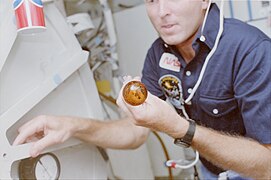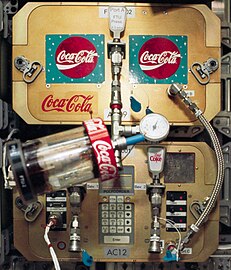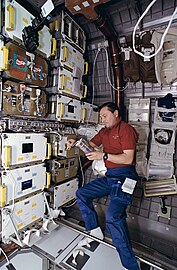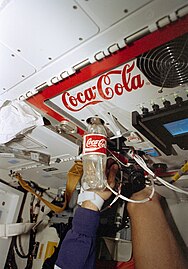User:Artem.G/sandbox4
1985: STS-51-F[edit]
In a heavily publicized marketing experiment, astronauts aboard STS-51-F drank carbonated beverages from specially designed cans from Cola Wars competitors Coca-Cola and Pepsi.[1] According to Acton, after Coke developed its experimental dispenser for an earlier shuttle flight, Pepsi insisted to the Presidency of Ronald Reagan that Coke should not be the first cola in space. The experiment was delayed until Pepsi could develop its own system, and the two companies' products were assigned to STS-51-F.[2]
Red Team tested Coke, and Blue Team tested Pepsi. As part of the experiment, each team was photographed with the cola logo. Acton said that while the sophisticated Coke system "dispensed soda kind of like what we're used to drinking on Earth", the Pepsi can was a shaving cream can with the Pepsi logo on a paper wrapper, which "dispensed soda filled with bubbles" that was "not very drinkable".[2] Acton said that when he gives speeches in schools, audiences are much more interested in hearing about the cola experiment than in solar physics.[2] Post-flight, the astronauts revealed that they preferred Tang, in part because it could be mixed on-orbit with existing chilled-water supplies, whereas there was no dedicated refrigeration equipment on board to chill the cans, which also fizzed excessively in microgravity.
Coca-Cola had gotten permission do an experiment in space to see if they could dispense carbonated beverages in weightlessness. They got approval to build this special can, put significant money into it, and were all set to fly it on one of the early shuttle missions. This was during the “Cola Wars,” when Ronald Reagan was in the White House. And somebody at a high level at Pepsi found out about this, went to their contacts in the White House and said, “This cannot be allowed to happen—that Coca-Cola would be the first cola in space.”
So the Coke can was taken off the mission it was supposed to go on, and Pepsi was given time to develop their own can so they could both fly on the same flight. It turned out that our 51-F mission ended up getting the privilege of carrying the first soda pop in space. Well, we got our cans for training. And indeed, the Coke can had had a lot of work put into it, and was designed to dispense a beverage without stirring up the liquid. The Pepsi can, when it showed up, looked like a shaving cream can. In fact, the Pepsi logo was just stuck on a paper wrapper, and when we peeled it off, indeed it was just a shaving cream can. It still had the shaving cream logo on it. Pepsi understood that this had nothing whatsoever to do with soda in space. It had to do with PR.
During training, the legal beagles at NASA headquarters got into the act. The rule came down that the cans would be covered during testing, so that no logo could be seen. And we would not be photographed during this testing. Then the directive came that the cans would be covered, but now we could be photographed. Then the next ruling was that the cans would be uncovered, the logo had to be visible, we could be photographed with still cameras, but we were not to be photographed with movie cameras. One thing after another came down, and this stupid thing was taking more time than our serious experiments. But we all took it in pretty good humor.
Well, the morning before the launch there is always a briefing, during which all the last minute things that need to be talked about get talked about. We were about halfway through a briefing on the latest data concerning the Sun—our flight had several solar physics experiments—when who should walk in but the Chief Counsel of NASA, who began to brief us once again on the Coke and Pepsi protocols.
At that point—and non-NASA payload specialists like me could get away with things that maybe career astronauts couldn’t—I just blew my stack and said, “We’ve been getting ready for this mission for seven years. It contains a great deal of science. We have a very short time to talk about the final operational things that we need to know. We don’t have time to talk about this stupid carbonated beverage dispenser test. Please leave.” He turned and walked out. But we did do our test in space. The red team did the Pepsi, and the blue team—we were divided into shifts—did the Coke. We took the still photographs, and we showed the logo. And indeed, the Coke can dispensed soda kind of like what we’re used to drinking on Earth. And the Pepsi can dispensed soda filled with bubbles—fun to play with in zero-g, but not very drinkable. Still, when I’m giving talks in schools, they are a lot more interested in Coke and Pepsi than they are in solar physics.
-
STS-51F Tony England drinks Coca Cola in space
-
STS-51F payload specialist Loren Acton evaluates a Pepsi space soda
-
Karl Henize, STS-51F mission specialist, creates frothy, fizzing Pepsi soda balls during the Carbonated Beverage Dispenser Evaluation on board the space shuttle Challenger
-
Karl Henize, STS-51F mission specialist, drinks from a Pepsi can
-
Gordon Fullerton, STS-51F mission commander, with a Coca-Cola can
-
Photographic documentation showing STS-51F crew activities. View of ball of liquid floating.
-
Photographic documentation showing STS-51F crew activities. Views include: Mission Specialist (MS) F. Story Musgrave with liquid drop in front of him.
-
STS-51-F Mission Specialist (MS) Karl G. Henize creating a circular drop from a container.
-
Coca Cola can designed for STS-51-F
1995: STS-63[edit]
BioServe Space Technologies at the University of Colorado, Boulder, developed the Fluids Generic Bioprocessing Apparatus-1 (FGBA-1) in cooperation with Coca-Cola and several other groups. It dispensed pre-mixed soda for astronauts' consumption and studied their changed taste perceptions. Astronauts rated control samples before and after flight.[3]
A Coca-Cola fountain dispenser (officially a Fluids Generic Bioprocessing Apparatus or FGBA) was developed for use on the Space Shuttle as a test bed to determine if carbonated beverages can be produced from separately stored carbon dioxide, water, and flavored syrups and determine if the resulting fluids can be made available for consumption without bubble nucleation and resulting foam formation. FGBA-1 flew on STS-63 in 1995 and dispensed pre-mixed beverages, followed by FGBA-2 on STS-77 the next year. The latter mixed CO₂, water, and syrup to make beverages. It supplied 1.65 liters each of Coca-Cola and Diet Coke.[4][5]
Fluids Generic Bioprocessing Apparatus (FGBA) located on the Space Shuttle Discovery's SPACEHAB during STS-63. The FGBA was used to evaluate the storage, manipulating, and dispensing of two-phase fluids in microgravity.
-
Fluids Generic Bioprocessing Apparatus on STS-63
-
Russian cosmonaut Vladimir Titov works with samples for the CGBA
-
Space Shuttle Coca-Cola dispenser, Atlanta, Georgia
1996: STS-77[edit]
A Coca-Cola fountain dispenser (officially a Fluids Generic Bioprocessing Apparatus-2 or FGBA-2) was developed for use on STS-77 as a test bed to determine if carbonated beverages can be produced from separately stored carbon dioxide, water and flavored syrups and determine if the resulting fluids can be made available for consumption without bubble nucleation and resulting foam formation. The unit held 1.65 liters (0.36 imp gal; 0.44 U.S. gal) each of Coca-Cola and Diet Coke.[6]
-
STS-77, Pilot Curtis Brown prepares to activate the Fluids Generic Bioprocessing Apparatus (FGBA) 2, on the middeck.
-
STS-77
-
Fluids Generic Bioprocessing Apparatus (FGBA) 2 on the Endeavour's middeck
https://www.colorado.edu/center/bioserve/spaceflight-hardware/fgba
http://www.collectspace.com/news/news-081120a-space-cola-wars-35-years.html
https://www.smithsonianmag.com/smithsonian-institution/the-cola-wars-smear-campaigns-in-space-27520139/
https://apnews.com/article/6f9ced6c83b319a3f3fcae4da770f096
https://www.washingtonpost.com/archive/politics/1985/07/12/cola-clash-is-taking-to-heavens/b40789de-0ce4-4086-a3e1-006ecb21d6f1/
https://goingtospace.com/russia/pepsi-ad-the-first-ad-shot-in-space-mirs-pepsi-ad
https://www.theatlantic.com/science/archive/2019/04/pepsi-advertisement-space/587608/
https://futurism.com/pepsi-orbital-billboard-night-sky
https://www.space-facts.co.uk/pepsi-advertisement-in-space
https://www.irishtimes.com/news/pepsi-films-ad-in-space-1.51492
https://history.nasa.gov/SP-4225/nasa2/nasa2.htm
http://www.whitelabelspace.com/2008/08/greatest-space-ads-part-iii-pepsi-on.html?m=1
https:// youtu.be/3tiew0XqRv0
- ^ Pearlman, Robert (May 31, 2001). "A Brief History of Space Marketing". Space.com. Archived from the original on February 14, 2009. Retrieved March 24, 2014.
- ^ a b c "Loren Acton: The Coke and Pepsi Flight". Air & Space/Smithsonian. Smithsonian Institution. November 18, 2010. Archived from the original on April 12, 2022.
- ^ "STS-63 Press Kit" (PDF) (Press release). Titusville, FL: NASA. February 1995.
- ^ Pearlman, Robert. "Coke machines on-board the space shuttle". CollectSpace. Archived from the original on October 22, 2018. Retrieved June 8, 2020.
- ^ Orloff, Richard W. (January 2001) [Press Kit May 1996]. "Space Shuttle Mission STS-77" (PDF). National Aeronautics and Space Administration. Archived (PDF) from the original on March 27, 2003. Retrieved June 13, 2009.
- ^ National Aeronautics and Space Administration accessdate 2009-06-13

















